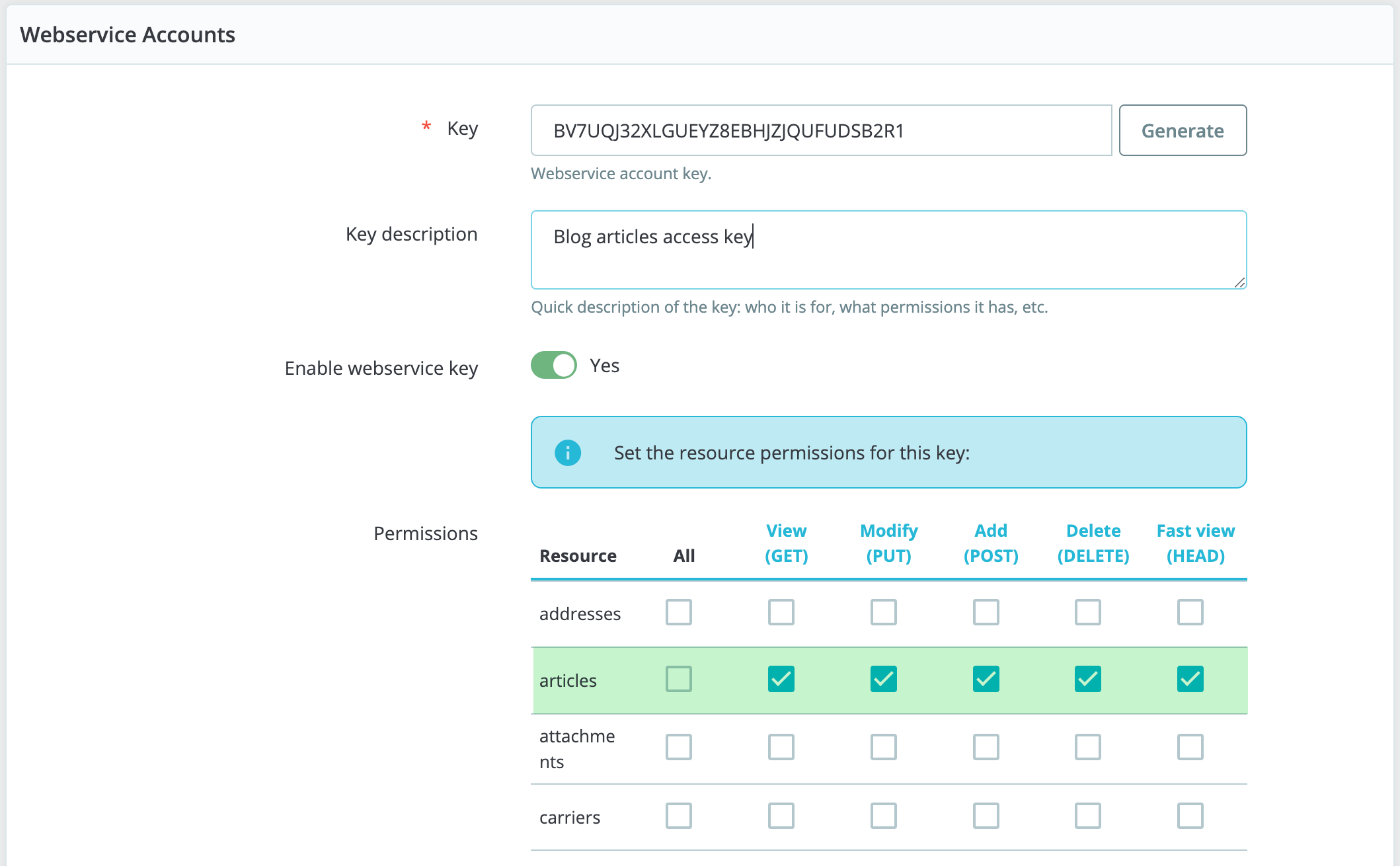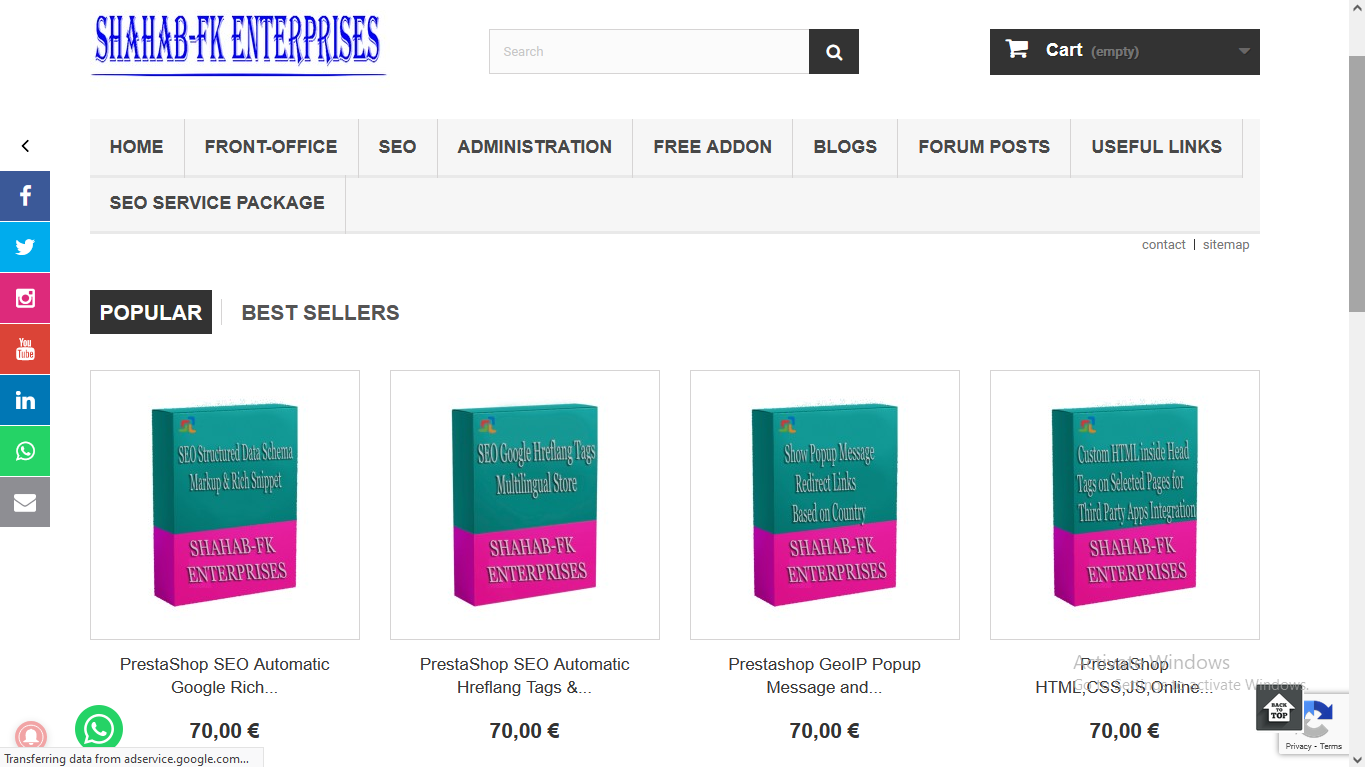PrestaShop Webservice
PrestaShop enables merchants to give third-party tools access to their shop’s database through a CRUD API, otherwise called a web service.
Since 1.7 version, developers can extend the resources available through the PrestaShop Webservice with a module.
Create and declare your new entity
The following example is about an entity that can manage blog articles, the folder where you create your Entity is not relevant.
PS: Remember to create the respective table(s) in the database, usually created during the module installation.
<?php
// modules/yourmodule/src/Entity/Article.php
class Article extends ObjectModel
{
public $title;
public $type;
public $content;
public $meta_title;
/**
* @see ObjectModel::$definition
*/
public static $definition = array(
'table' => 'article',
'primary' => 'id_article',
'multilang' => true,
'fields' => array(
'type' => array('type' => self::TYPE_STRING, 'validate' => 'isCleanHtml', 'required' => true, 'size' => 255),
'date_add' => ['type' => self::TYPE_DATE, 'validate' => 'isDate'],
'date_upd' => ['type' => self::TYPE_DATE, 'validate' => 'isDate'],
// Lang fields
'title' => array('type' => self::TYPE_STRING, 'validate' => 'isCleanHtml', 'required' => true, 'size' => 255),
'content' => array('type' => self::TYPE_HTML, 'lang' => true, 'validate' => 'isCleanHtml', 'size' => 4000),
'meta_title' => array('type' => self::TYPE_STRING, 'lang' => true, 'validate' => 'isCleanHtml', 'size' => 255)
)
);
protected $webserviceParameters = array(
'objectNodeName' => 'article',
'objectsNodeName' => 'articles',
'fields' => array(
'title' => array('required' => true),
'type' => array('required' => true),
'content' => array(),
'meta_title' => array(),
)
);
}
The $webserviceParameters array is mandatory to define how and which fields to expose.
The key to access all the elements:
'objectsNodeName' => 'articles'
The key to access a single element:
'objectNodeName' => 'articles'
The parameter to set which fields to expose through the webservice and settings for each of them:
'fields' => array()
Registration with a hook
The hook addWebserviceResources must be registered and implemented by your module.
public function hookAddWebserviceResources($params)
{
return [
'articles' => [
'description' => 'Blog articles', // The description for those who access to this resource through WS
'class' => 'Article', // The classname of your Entity
'forbidden_method' => array('DELETE') // Optional, if you want to forbid some methods
]
];
}
Load your entity
Don’t forget to include the class file of your entity (i.e. Article.php) at the top of your main module file. The following is an example of a correct configuration to load your example entity to your module.
include_once _PS_MODULE_DIR_ . 'wsarticle/src/Entity/Article.php';
Complete example of a main module file
<?php
if (!defined('_PS_VERSION_')) {
exit;
}
include_once _PS_MODULE_DIR_ . 'wsarticle/src/Entity/Article.php';
class WsArticle extends Module
{
public function __construct()
{
$this->name = 'wsarticle';
$this->tab = 'front_office_features';
$this->version = '1.0.0';
$this->author = 'PrestaShop';
$this->need_instance = 0;
$this->secure_key = Tools::encrypt($this->name);
$this->bootstrap = true;
parent::__construct();
$this->displayName = $this->getTranslator()->trans('Extend WS demo module', array(), 'Modules.Wsarticle.Admin');
}
public function install()
{
return parent::install() &&
$this->installDB() && // Create tables in the DB
$this->registerHook('addWebserviceResources'); // Register the module to the hook
}
public function installDB()
{
$sql = 'CREATE TABLE IF NOT EXISTS `'._DB_PREFIX_.Article::$definition['table'].'` (
`id_article` int(10) unsigned NOT NULL AUTO_INCREMENT,
`type` varchar(255),
`date_add` datetime NOT NULL,
`date_upd` datetime NOT NULL,
PRIMARY KEY (`id_article`)
) ENGINE='._MYSQL_ENGINE_.' DEFAULT CHARSET=utf8mb4 COLLATE=utf8mb4_general_ci';
$sql_lang = 'CREATE TABLE IF NOT EXISTS `'._DB_PREFIX_.Article::$definition['table'].'_lang` (
`id_article` int(10) unsigned NOT NULL,
`id_lang` int(10) unsigned NOT NULL,
`title` varchar(255),
`content` text NOT NULL,
`meta_title` varchar(255) NOT NULL,
PRIMARY KEY (`id_article`, `id_lang`)
) ENGINE='._MYSQL_ENGINE_.' DEFAULT CHARSET=utf8mb4 COLLATE=utf8mb4_general_ci';
if (Db::getInstance()->execute($sql) && Db::getInstance()->execute($sql_lang)) {
return true;
}
return false;
}
public function hookAddWebserviceResources($params)
{
return [
'articles' => array(
'description' => 'Blog articles', // The description for those who access to this resource through WS
'class' => 'Article', // The classname of your Entity
'forbidden_method' => array('DELETE') // Optional, if you want to forbid some methods
)
];
}
}
Final notes
Following the example above, the new resource will be available in the webservice resources list:

New Webservice resource
This new resource will be accessible through your API endpoint behind the name that you set in objectsNodeName, for instance:
https://mywebsite.shop/api/articles
will return something similar to what you can see on the screenshot below (it is the XML response previewed in the browser):

Webservice articles list (empty)
And something like on the next screenshot, if you have articles in the database:


